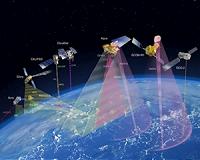 |
Austin TX (SPX) Mar 25, 2011 Two satellites designed and constructed by students at the Cockrell School of Engineering successfully separated in space March 22, completing the most crucial goal of the mission since its Nov. 19 launch and making them the first student-developed mission in the world in which satellites orbit and communicate with each other in real-time. The satellites separated March 22 at 6:35 a.m. Central Standard Time. Now that they're apart, the 60-plus pound, tire-sized satellites will be able to perform the main goals of the project and could pave the way for more complex satellite missions that require real-time coordination between small satellites. Traditionally, larger and expensive satellites have been commonplace in space missions but the satellites developed by more than 150 aerospace engineering graduate and undergraduate students could demonstrate the potential for space technology that's more affordable and accessible-a forward-looking approach that's attracted the interest of the Air Force and NASA. The smaller satellites could also help prevent tragedies like the Columbia space shuttle disaster, which, unknown to the shuttle's crew, had a hole in the left wing that caused it to disintegrate upon reentry to the Earth's atmosphere Feb. 1, 2003, killing all seven onboard. "If they would have had the technology that could go outside the shuttle and inspect it, then the hole could have been discovered," Lightsey said. The students, led by their faculty advisor Professor Glenn Lightsey, built the satellites over the course of seven years using a shoestring hardware budget of $250,000 - a small amount compared to the millions typically spent on spacecraft missions. They were launched into orbit from Alaska's Kodiak Launch Complex in November, a moment that was considered the pinnacle of the students' years of work. But the real moment of truth came early Tuesday morning when they separated, said Lightsey. "We had to work through some problems on the satellites to get the separation to occur, but the student-team figured out a way to get the command to work. I am very proud of all of them," said Lightsey. "We have achieved a true first in spacecraft engineering." The satellites will collect scientific data and be able to report their location and proximity to each other to students and amateur radio operators tracking their orbit some 400 miles above.
Share This Article With Planet Earth
Related Links University of Texas at Austin Space Technology News - Applications and Research
 WTA Releases New Satellite Operator Benchmarks Report
WTA Releases New Satellite Operator Benchmarks ReportNew York NY (SPX) Mar 24, 2011 The World Teleport Association has published a new report, Satellite Operator Benchmarks 2011, in which teleport operators worldwide rate the commercial and operational performance of the top satellite operators, with the intention of driving positive industry improvements. Satellite Operator Benchmarks 2011 provides satisfaction ratings and feedback from 70 interviews with teleport execut ... read more |
|
| The content herein, unless otherwise known to be public domain, are Copyright 1995-2010 - SpaceDaily. AFP and UPI Wire Stories are copyright Agence France-Presse and United Press International. ESA Portal Reports are copyright European Space Agency. All NASA sourced material is public domain. Additional copyrights may apply in whole or part to other bona fide parties. Advertising does not imply endorsement,agreement or approval of any opinions, statements or information provided by SpaceDaily on any Web page published or hosted by SpaceDaily. Privacy Statement |